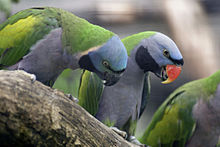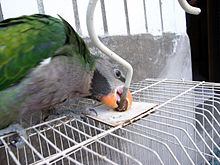- Lord Derby's Parakeet
-
Lord Derby's Parakeet 
A pair - male on left and female on right Conservation status Scientific classification Kingdom: Animalia Phylum: Chordata Class: Aves Order: Psittaciformes Family: Psittacidae Genus: Psittacula Species: P. derbiana Binomial name Psittacula derbiana
(Fraser, 1852[verification needed])The Lord Derby's Parakeet (Psittacula derbiana), also known as Derbyan Parakeet, is a monotypic[1] parrot species, which is confined to small pocket of moist evergreen forest in the hills of the Indian state of Arunachal Pradesh and the Chinese province on its border. The species suffers from poaching for the illegal wildlife trade and fetches a high price in the black market. It is perhaps the rarest of all species of Psittacula in mainland Asia. The adult male and female are easily distinguished because they have different beak colours and slightly different plumage.
The name of this bird commemorates Edward Stanley, 13th Earl of Derby.
Lord Derby's Parakeets feed on fruits, berries, seeds, and leaf buds, occasionally foraging in gardens and fields.
Contents
Description
Lord Derby's Parakeets average 20 inches (50 centimeters) in length and are sexually dimorphic. They have a mostly green plumage over their dorsal surface (i.e. from behind), black lores and lower cheeks, a bluish-purple crown and pale yellow eyes. The throat, breast, abdomen and under-wing coverts are greyish blue to lavender. The thighs and vent area are yellowish green with blue edging on some of the feathers. The tail feathers are shades of green, some edged with blue. Male birds have a red upper mandible with a yellow tip, while the lower mandible is black. The females have an all-black beak.
Immature Lord Derby's Parakeets are duller in colour than the adults. Juvenile birds have green crowns, orange-red upper and lower mandible (beak), and their irises are dark and do not lighten until they reach maturity between two and three years of age.
Sexual dimorphism
- Adult male
- Adult female
Reproduction
Breeding season usually begins between April and June. The female lays a clutch of two to four eggs (36.1x27.7 mm (1.42 x 1.09 ins) in nest holes of trees. The young hatch after an incubation period of about 23 days and will fledge after 8 to 9 weeks.
References
- ^ "Zoological Nomenclature Resource: Psittaciformes (Version 9.022)". www.zoonomen.net. 2009-03-31. http://www.zoonomen.net/avtax/psit.html.
- BirdLife International (2008). Psittacula derbiana. In: IUCN 2008. IUCN Red List of Threatened Species. Downloaded on 11 April 2009.
External links
- World Parrot Trust Parrot Encyclopedia - Species Profiles
- Derbyan pictures and links
- BirdLife Species Factsheet
- Oriental Bird Images: Derbyan Parakeet Selected photos
- http://animal-world.com/encyclo/birds/parakeets/DerbyanParakeet.php#
- http://home.wanadoo.nl/psittaculaworld/PsittaculaWorld.htm
- http://en.wikipedia.org/wiki/Derbyan_Parakeet
- http://www.ruffledfeathersaviary.com/derbyan_photos.htm
Tribus: Psittaculini Genus Species (taxonomy note: * Réunion Parakeet and Mauritius Parakeet may united as subspecies or split as separate species)
(extinctions: † indicates a species confirmed to be extinct, ₴ indicates evidence only from sub-fossils)Psittinus Psittacella Brehm's Tiger Parrot • Painted Tiger Parrot • Modest Tiger Parrot • Madarasz's Tiger ParrotGeoffroyus Red-cheeked Parrot (or Singing Parrot) • Blue-collared Parrot • Song ParrotPrioniturus Montane Racket-tail • Mindanao Racket-tail • Blue-headed Racket-tail • Green Racket-tail • Blue-crowned Racket-tail • Blue-winged Racket-tail (or Sulu Racket-tail) • Yellow-breasted Racket-tail • Golden-mantled Racket-tail • Buru Racket-tailTanygnathus Eclectus Alisterus Aprosmictus Jonquil Parrot (or Olive-shouldered Parrot) • Red-winged ParrotPolytelis Psittacula Alexandrine Parakeet (or Alexandrine Parrot) • Seychelles Parakeet † • Rose-ringed Parakeet (or Ringnecked Parakeet) • Réunion Parakeet † * • Mauritius Parakeet * • Newton's Parakeet † • Slaty-headed Parakeet • Grey-headed Parakeet • Plum-headed Parakeet • Blossom-headed Parakeet • Lord Derby's Parakeet • Red-breasted Parakeet • Nicobar Parakeet • Long-tailed ParakeetLoriculus Vernal Hanging Parrot • Sri Lanka Hanging Parrot • Philippine Hanging Parrot (supporting pages: Cebu Hanging Parrot and Camiguin Hanging Parrot) • Blue-crowned Hanging Parrot • Great Hanging Parrot (or Sulawesi Hanging Parrot) • Sula Hanging Parrot • Moluccan Hanging Parrot • Sangihe Hanging Parrot • Orange-fronted Hanging Parrot (or Papuan Hanging Parrot) • Bismarck Hanging Parrot (or Green-fronted Hanging Parrot • Pygmy Hanging Parrot (or Red-billed Hanging Parrot) • Yellow-throated Hanging Parrot • Wallace's Hanging Parrot • Camiguin Hanging ParrotAgapornis Rosy-faced Lovebird (supporting page: Rosy-faced Lovebird colour genetics) • Yellow-collared Lovebird (or Masked Lovebird ) • Fischer's Lovebird • Lilian's Lovebird • Black-cheeked Lovebird • Grey-headed Lovebird (or Madagascar Lovebird) • Black-winged Lovebird (or Abyssinian Lovebird) • Red-headed Lovebird (or Red-faced Lovebird) • Black-collared Lovebirdincertae sedis
(probably Psittaculini)Mascarene Parrot † (genus: Mascarinus) • Broad-billed Parrot † (genus: Lophopsittacus) • Rodrigues Parrot † (genus: Necropsittacus)
This article relating to parrots is a stub. You can help Wikipedia by expanding it.








